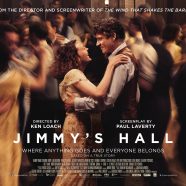JIMMY’S HALL BY GRAHAM HARRINGTON
I recently viewed the 2014 film “Jimmy’s Hall” directed by Ken Loach (“The Wind that shakes the Barley,” Hidden Agenda,” “Land And Freedom.”) The film centres on the rather remarkable real-life story of Jimmy Gralton. Gralton (played by Barry Ward) was a communist political and social activist from Leitrim who was, shall we say, “disliked” by the conservative authorities in his home parish in 1930s Ireland. Gralton established a hall where young people could meet, dance, discuss topics and be educated. The local clergy viewed it as a hotspot for communist propaganda, with young people reading things such as Connolly’s “Labour In Irish History” and other Marxist texts. The local priest, Fr.Sheridan (played by yer man Bishop Brennan) rallies the local Blueshirts (a fascist movement operating in Ireland during the ’30s) and property owners against Gralton’s hall. The names of the attendees of the dances and sessions at the hall are read out at Mass, which leads to a horrific scene concerning the brutal nature of the local Blueshirt O’Keefe. At one stage, the hall is attacked and shots are even fired into it by the Blueshirts despite people being inside.
The film can be seen as a case study of Ireland during this period.It was a time of polarisation, repression, transformation and uncertainty. In my favourite scene, a group of IRA men come to Gralton and ask him to use his charisma to help them support a tenant and his family who are being evicted by their landlord. There is a large crowd present and the landlord is scared off; Jimmy then makes an impassioned speech to the crowd. This scene is meant to show the opposing viewpoints of the increasingly left-leaning IRA at the time and the as ever conservative Church. Later on, Fr Sheridan and the local authorities discuss the consequences of the events of the 1934 Wolfe Tone Bodenstown commemoration where Catholics and Protestants marched together.
There’s also the obligatory love story, although I didn’t think it was a bad one. It concerns Jimmy and his former lover Oonagh. She and Jimmy were madly in love prior to his emigrating, but now she is married and has children. I thought the film would do the typical thing of “they get together and then her husband finds out and gives the Blueshirts information about Jimmy,” but, to be fair, Jimmy and Oonagh accept their situation and the fact they cannot be together. There is also a beautiful relationship between Jimmy and his mother. I saw a lot of my own grandmother in her. At one stage, the Gardaí raid her house looking for Jimmy and she sits down and makes them tea. I thought this really encapsulated the nature of a generation of Irish people which I have long admired.
The local authorities resort to extra-legal measures to rid themselves of Gralton. They find some loopholes which allow them to extradite Jimmy back to America and forbid him from returning to Ireland. Jimmy goes on the run but is captured. While he is being put on the truck, never to see his mother again, Oonagh or his beloved people again, the Blueshirts begin mocking him until Fr Sheridan lambasts them saying, “Show him some respect. He has more honour and integrity than the lot of you put together.” I thought this was brilliant directing from Loach.
“Jimmy’s Hall” is a must-see film. It is also a stark reality check for those in power today whose not-so-far-off origins are shown. It is a very romantic and poignant film but fairly accurate in showing the real-life story of Jimmy Gralton. It makes me proud to be Irish, proud to be working-class, proud to be a communist, but also proud to be human.






